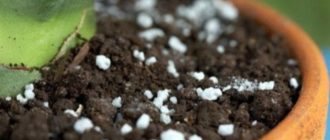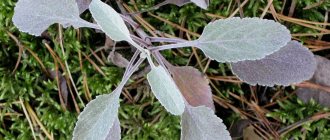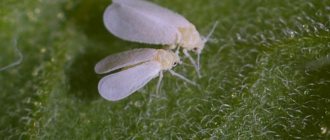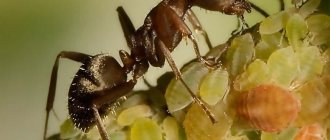Sometimes diseases and pests destroy roses in a matter of weeks. In order not to lose precious seedlings, you need to know by sight everyone who is capable of harming your flower beds, and in the case of roses there are many of them.
In addition to the well-known aphids and rust, numerous bacterial and fungal diseases, as well as insect pests, attack the leaves and buds. Even those that are not able to completely destroy the bushes weaken them, reduce their decorative value and affect flowering. To enjoy the aroma of roses all the time, you need to quickly respond to the slightest changes and competently treat and protect your rose garden.
Fungal disease of roses: powdery mildew: photo and treatment
Fungal disease of roses powdery mildew in the photo
With the fungal disease of roses powdery mildew, a powdery coating appears on young leaves, shoots and buds; thickening and curvature are observed.
As can be seen in the photo, powdery mildew on roses appears as a whitish coating, which is a mycelium and sporulation of the fungus:
The pathogen overwinters in the form of mycelium in the kidneys. The development of the disease is facilitated by excess nitrogen fertilizer, lack of calcium in the soil, drying out of the soil, too light sandy or, conversely, cold, damp soils.
The disease develops especially strongly with insufficient lighting and high air humidity. Sudden changes in temperature, drafts, drying out of the soil and other conditions that disrupt the normal life of plants reduce their resistance to disease. Tea and hybrid tea roses with more delicate foliage are especially affected.
Rose varieties that are resistant to powdery mildew are those that have dense, glossy leaves of the “Gloria Day” type.
To treat powdery mildew on roses, when the first signs of the disease appear, it is necessary to spray the bushes with Topaz, Chistotsvet, Fundazol or Skor. At temperatures above 22° C, spraying with “Grey colloidal” or “Tiovit Jet” is possible. If necessary, to combat this disease of roses, treatments are repeated as new growth and powdery mildew spots appear on them.
Improper care
Even with proper planting, acceptable temperature conditions, and regular spraying, if a rose in a pot withers, you should pay attention to important factors:
- the home rose is in direct sunlight;
- the rose is at risk of excessive watering or cold, unsettled water;
- lack of nitrogen in the fertilizer;
- lack of iron in the soil;
- you are using too many chemicals.
All this leads to the flower dying. If you recognize these negative factors in time, you can protect your favorite roses from death.
Rose rust: photos and treatment when fighting the disease
Rust of roses in the photo
With this disease of roses, the affected parts of the shoots become bent and thickened. In spring, orange dust appears on the stems near the opening buds and at the root collar. This is the spring sporulation of the fungus, the causative agent of the stem form of rust. The fungus overwinters in plant tissues infected in previous years. The disease develops more intensely in years with warm and wet springs.
Rust fungi not only take away nutrients from the plant, but also severely disrupt its physiological functions: they increase transpiration, reduce photosynthesis, make breathing difficult and worsen metabolism.
With rose disease, rust on the leaves on the underside in summer, small, red-yellow pads of summer spores form, which can give rise to several generations and infect new plants.
In the second half of summer, winter sporulation begins to appear on the underside of the leaves in the form of small round black pads.
Look at the photo - if this rose disease has severely affected the plant, the entire leaves turn yellow and fall off prematurely:
The spread of rust fungus spores occurs with air flow, water, and planting material.
To protect roses from this disease, one-way nitrogen fertilization should be avoided. In the fall, it is necessary to remove and burn the affected foliage, and in the early spring (before the buds open) spray the plants and the soil around them with iron sulfate (1-1.5%). The soil under the bushes must be loosened and mulched to reduce infection.
To treat rose rust, it is necessary to carefully and promptly trim shoots affected by the stem form of rust; from the moment the buds open, re-spray the plants with Bordeaux mixture (1%) or its substitutes (“Oxychom”, “Abiga-Peak”, “Hom”, “ Copper oxychloride", "Ordan").
Next, you can see photos and descriptions of rose diseases such as black spot, bacterial cancer, gray rot, branch burn and cytosporosis.
Rose leaf roller
Rose leaf roller
(Orchis rosae)
- butterflies whose small blackish-green caterpillars damage young shoots, buds and leaves that curl up in the shape of a cigar.
Rose leaf roller. Photo from wikipedia.org
Control measures
The easiest way to fight is to collect and destroy the caterpillars.
Treatment of rose bushes with systemic or bacterial preparations, as well as a decoction of tobacco and garlic
or onions.
Bacterial rose cancer disease: photo and treatment of flowers
Bacterial rose cancer disease in the photo
With bacterial canker of roses, growths of varying sizes form on the root collar and roots of plants. Sometimes they are barely noticeable, but often reach several centimeters in diameter. The growths have an uneven tuberculate surface. They consist of soft tissue, first white, then brown, and are decomposed by bacteria in the soil.
There are also hard, lignified growths that grow every year. Less commonly, the above-ground part is affected - trunks and branches, mainly in climbing and standard remontant roses. Here, tuberous nodules and tumors of various sizes are formed.
Green rose aphid
This pest
(Macrosiphum rosae)
appears in the spring and is located in dense colonies, multiplying very quickly. Affects leaves, buds and young shoots. Aphids suck out the sap and weaken the plants. Overwinters on the above-ground parts of plants.
Green rose aphid
Control measures
It is necessary to carry out two to three treatments with an interval of three days with insecticides of systemic and contact action: Actellik, Aktara, Fufanon or a soap solution, decoctions of tobacco, pepper, garlic.
Recipe for fighting aphids from I. V. Michurin
Take a little soap solution, add a little tobacco decoction, 1 glass of ash and kerosene. Stir well. Spray the plants with the resulting solution. The aphids will disappear in a couple of days.
Fungal disease burn of rose branches: photos and control measures
Fungal disease burns rose branches in the photo
Branch burn is a fungal disease in which reddish spots initially appear on the branches, later darkening in the middle; the red-brown border persists for quite a long time. As the spots grow, they ring the branches. Tissue sagging may form above the affected area. Diseased branches usually dry out at the end of summer.
The development of “burn” is facilitated by excess humidity under the winter shelter.
To avoid severe damage to roses, cover should be removed earlier in the spring. Sick and frozen branches must be pruned and burned in a timely manner.
As shown in the photo, when treating this disease of roses, plants need to be sprayed with preparations containing copper, as in the fight against rust:
Proper agricultural practices (timely application of fertilizers, loosening and watering) help reduce the severity of the disease. It is necessary to achieve good ripening of the wood until the end of the plant growing season.
For the winter, plants with already fallen leaves should be covered in dry weather if possible, so that increased humidity is not created under the cover. Before covering, unripe shoots with green leaves are removed, and the plants are sprayed with a 3% Bordeaux mixture or a 1.5% solution of ferrous sulfate.
Growing conditions
The rose indoor plant requires certain conditions for growing and compliance with all the nuances of care.
Necessary lighting: roses are light-loving, so they are placed on the windowsills of south-west and south-east windows. Near the northern windows they will not have enough lighting and may not wait for flowering. In this case, illumination with phytolamps with a red-blue color is necessary.
If you place the plant on a south window, where direct sunlight hits in the summer, the leaves will dry out and the buds will quickly fade. If there is no other place, then the flower can be shaded using a light tulle curtain. In order for the crown to develop evenly, it is recommended to turn the pot with the bush a little every day.
Air temperature and humidity
When caring for indoor roses, you should know that the plant does not tolerate high temperatures and dry air. At home, roses are grown at a moderate air temperature of about +22 degrees.
It is very good if the temperature drops at night. In the warm season, you can place the flower pot on the open balcony.
Air humidity, which must be increased, is very important for roses. Many gardeners complain that the leaves of their flowers have begun to fall off. It's all about dry air, in which the plant can be attacked by spider mites.
In warm rooms, it is recommended to spray the leaves once or even twice a day with settled water at room temperature. In a cool room, frequent spraying is not necessary. Spraying is carried out at a time when the bush is not exposed to sunlight.
You can increase the humidity using special air humidifiers, or by placing the pot in a tray filled with damp expanded clay or moss. A decorative rose will be grateful if you give it a warm shower from time to time. The dust will be washed off from its leaves, and the plant will take on a fresh look.
Watering and fertilizing
When caring for an indoor rose, you need to take care of the earthen lump, which should not be overdried or waterlogged. In summer, regular watering is important, which is carried out after the top layer of soil has dried.
The frequency of watering depends on the microclimate. If the room is hot, the soil is moistened more often than when the flower is kept in cool home conditions. After watering, the water from the pan must be drained.
Treatment of roses to protect against cytosporosis disease
Cytosporosis is a fungal disease of roses in the photo
Cytosporosis is a fungal disease that is widespread throughout the world. Roses affect a number of ornamental shrubs, as well as pome and stone fruit trees and nuts.
Cytosporosis is also called infectious drying out. In some years, it leads not only to the drying out of individual branches, but also to the death of plants. Bushes that are weakened as a result of freezing, drought, sunburn, untimely pruning, etc. are especially susceptible to this disease.
First, the causative agent of the disease settles on dying individual areas of the bark. Large, clearly visible orange-red fungal pycnidia tubercles appear over the entire area of the affected bark, protruding from under the skin.
Try varieties of hybrid tea roses from a trusted supplier:











